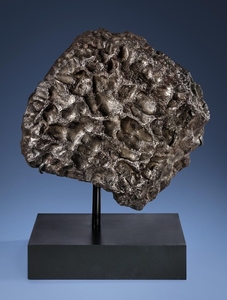MASSIVE SCULPTURE FROM OUTER SPACE — AESTHETIC CAMPO DEL CIELO IRON METEORITE, Iron, coarse octahedrite – IAB-MG Gran Chaco, Argentina (27°28' S, 60°35' W)
Resembling an asteroid in miniature this rounded mass has a surface covered with the tell-tale thumbprints that result from atmospheric frictional heating. The ridges are smooth and the surface texture appears finely stippled. Deceptively dense, this meteorite is blanketed in a gunmetal patina with platinum accents. Accompanied by a custom pedestal.
377 x 354 x 246 mm. (14¾ x 13¾ x 9⅔ in.) and 84.8 kg. (187 lbs)
A rare example of a massive meteorite exhibiting sought-after aesthetics. Thousands of years after landing on Earth, Campo del Cielo (“Valley of the Sky”) meteorites were first written about in 1576 by Spanish explorers in Argentina when their unearthly origins were not yet understood. It was a “Campo” that was the first large meteorite ever displayed in a major museum — the British Museum of Natural History — and several large Campo del Cielo masses can be found today in the finest museums in the world. Few, if any, possess as finely articulated regmaglypts (the flight markings acquired from burning through Earth’s atmosphere) as seen on the example now offered.
Campo del Cielo meteorites formed as the result of two asteroids colliding at cosmic velocity in interplanetary space. When a large fragment from one of these asteroids hit Earth’s upper atmosphere more than 4,000 years ago, the immense pressure exerted on the mass caused it to explode into thousands of pieces. The larger meteorites struck the ground at such a high velocity that an array of at least 26 impact craters formed, the largest a football field in diameter.
Christie's would like to thank Dr. Alan E. Rubin at the Institute of Geophysics and Planetary Physics, University of California, Los Angeles for his assistance in preparing this catalog note.
View it on
Sale price
Estimate
Time, Location
Auction House
Resembling an asteroid in miniature this rounded mass has a surface covered with the tell-tale thumbprints that result from atmospheric frictional heating. The ridges are smooth and the surface texture appears finely stippled. Deceptively dense, this meteorite is blanketed in a gunmetal patina with platinum accents. Accompanied by a custom pedestal.
377 x 354 x 246 mm. (14¾ x 13¾ x 9⅔ in.) and 84.8 kg. (187 lbs)
A rare example of a massive meteorite exhibiting sought-after aesthetics. Thousands of years after landing on Earth, Campo del Cielo (“Valley of the Sky”) meteorites were first written about in 1576 by Spanish explorers in Argentina when their unearthly origins were not yet understood. It was a “Campo” that was the first large meteorite ever displayed in a major museum — the British Museum of Natural History — and several large Campo del Cielo masses can be found today in the finest museums in the world. Few, if any, possess as finely articulated regmaglypts (the flight markings acquired from burning through Earth’s atmosphere) as seen on the example now offered.
Campo del Cielo meteorites formed as the result of two asteroids colliding at cosmic velocity in interplanetary space. When a large fragment from one of these asteroids hit Earth’s upper atmosphere more than 4,000 years ago, the immense pressure exerted on the mass caused it to explode into thousands of pieces. The larger meteorites struck the ground at such a high velocity that an array of at least 26 impact craters formed, the largest a football field in diameter.
Christie's would like to thank Dr. Alan E. Rubin at the Institute of Geophysics and Planetary Physics, University of California, Los Angeles for his assistance in preparing this catalog note.



